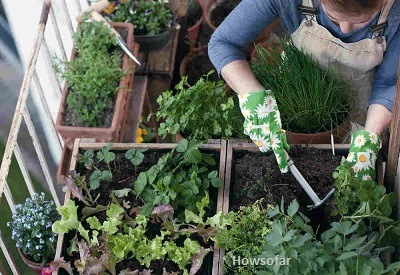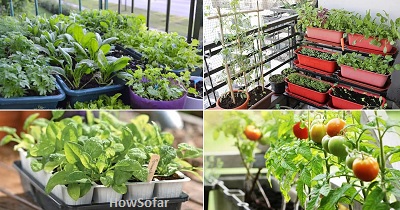A balcony in an apartment is a place that can be adapted for any purpose. It can not only store preservation and children’s sleds but also equip a cozy lounge area with a sofa and garlands, organize a comfortable workplace, or turn it into a workshop that will inspire. And you can create an apartment greenhouse or even a vegetable garden – not only petunias can grow here, but also healthy greens that will delight your taste buds all year round.

If the latter option interests you more than others, here you will find recommendations on how to properly grow your favorite dill with spinach at home and enjoy fresh herbs at any time of the year.
How to organize a “garden” in the apartment
So, you set out to grow greens in the house. What needs to be considered before you start planting sweets in pots?
- Determine a place for the “bed”. First of all, think about where you will place pots of greens on the balcony. If you want to start small (parsley and lettuce, for example), perhaps a window sill will be enough for you – you can easily put several containers on it and wait for the first harvest. But if you have Napoleonic plans and you want to grow a lot of different greens, it is better to install additional shelves or put up a rack.
- Lighting. Almost all “green” cultures love a lot of light. For example, for normal growth, dill needs at least 6 hours of good lighting per day. Therefore, when determining the location of the pots, choose the sunny side. If your balcony is in the shade, it is better to take care of additional lighting and put in ultraviolet lamps.
- Temperature regime and plan “B”. For most types of greens, the optimal temperature for growing is in the range of 17 to 21°C. On an open balcony, plants feel great in spring, summer and until mid-autumn, and on an insulated one they can please you even longer. But if you plan to grow greens in the winter, you should consider a backup plan and determine a place in the apartment where you can move the pots for the cold season. And, since daylight hours are short in winter, artificial ultraviolet lighting is indispensable.
- Air humidity. Greens love moisture – that’s a fact. Therefore, along with regular watering, it would be nice to provide the necessary level of humidity. An indicator of 50-60% is considered optimal. If you grow greens on a glazed balcony or in an apartment, the most effective solution is a humidifier, which can be purchased at a hardware store. But it is not suitable for an open balcony, therefore, in this case, it is necessary to regulate the humidity by daily spraying of the sprouts.
What you need to grow greens in the house
We have decided on the place and suitable conditions, now it’s time to make a list of what you need for your cozy apartment “garden”:

- Pots – choose not very deep (up to 10-15 cm) and wide containers, they will be more convenient;
- Drainage (expanded clay or medium-sized pebbles) – will help avoid root rot;
- Soil – for growing greenery at home, you can use a special soil or universal soil for indoor flowers;
- Seeds – choose early-ripening varieties of greens that will give the first harvest in a few weeks: parsley, lettuce, arugula, spinach, dill, celery, mint, basil, cilantro, marjoram;
- Spray gun for spraying;
- Additional means to create optimal conditions (optional) – a humidifier and ultraviolet lamps.
Let’s start planting: features of growing different types of greenery
At home, different “green” crops are grown in slightly different ways. Some just need to be planted in the ground, watered, and wait for the first sprouts, while the seeds of others need to be soaked in water for several days. Below you will find a brief guide to planting and caring for the most popular “apartment” greenery.
Salad
Growing a crispy vitamin salad on your windowsill is easy. It sprouts quickly and with proper care you will get the first harvest within a month.
Lettuce needs a lot of space, so it is recommended to plant it in a pot with a gap of at least 10 cm or use separate containers for each future bush – this way it will be more lush. Make a small depression in the ground (1-1.5 cm), plant the seeds, and sprinkle with earth and fields with settled water at room temperature. To speed up the appearance of the first shoots, it is recommended to create a greenhouse effect by covering the pot with crops with cling film for 3-5 days.

Also Related 40+ Unique DIY Flower Pot Ideas to Brighten Up Your Home
Lettuce is a moisture and light-loving crop, so make sure that the soil is always moist, place the pots on the sunny side, and do not forget to spray it every day. If the salad is not provided with the right conditions, the leaves will certainly grow, but they can be bitter in taste.
Dill
To grow fragrant dill on the windowsill, you first need to prepare the seeds. Since they contain a lot of essential oils, soak them in warm water in a flat container for 1-2 days, changing the liquid several times a day. Instead of a container of water, you can use a damp cotton cloth. After this stage, you can start landing.
Make small indentations in a pot of soil, lay out the prepared seeds, and sprinkle them with earth and fields. Cover the crops with cling film for a few days. It can be removed as soon as the first shoots appear. Provide dill with good long-term lighting (from 6 hours a day) and regular watering, and then in 30-40 days you will be able to harvest the first fragrant crop grown with your own hands.
Parsley
Curly parsley is grown in the same way as dill. Prepare the seeds by soaking them in water for a few days. Plant them in small holes in the ground, and sprinkle with earth and fields. Remember that parsley grows longer than dill – on average, about 1.5-2 months. And it is just as demanding on lighting and humidity.
Green onion
Onions are perhaps the most unpretentious type of greens for growing at home. He doesn’t even need soil, it’s enough to take an onion (it’s better to take one that has already fired an “arrow”) and lower its roots into a jar of water. After a week or two, you can already reap the first “fruits”.
But in the ground, the onion feels no worse. To grow it in a pot, take small onion heads, dip them about one-third into the ground, and sprinkle the soil well with water. The soil should always be moist but do not flood it so that the roots do not start to deteriorate.
Life hack. If you want green onions to always be on your menu, plant them in two pots: in one immediately, and in the second after 2 weeks. While you are enjoying the harvest of the first planting, the second will just arrive.
Basil
If you love the spicy taste of basil, you can also grow it on your windowsill. Unlike many types of greenery, it needs a higher temperature (about 25 ° C) to grow, so it is better to plant it in late spring on the south side of the apartment.
Seeds need to be prepared by soaking in water for several days. After that, the basil can be planted in the ground at a distance of about 7 cm from each other and covered with a film until the sprouts emerge. It will grow in about 1-1.5 months, but to speed up growth, it can be fed with nitrogen fertilizer.
You can speed up the process if you grow basil not from seeds, but from a stem. In this case, put the stems in a container of water for 5-6 days. As soon as the roots appear, we transplant into the ground and do not forget to spray the foliage every day. To make the bush more lush and thick, the top can be trimmed. By the way, if the basil has thrown out the buds, they need to be cut off immediately so that dense greenery is formed.
Mint
Just like basil, mint in an apartment can be grown both from seeds and from a stem. In the first case, mint seeds are soaked in water for several days, planted in the soil at a depth of about 0.5-1 cm, and covered with a film to accelerate germination. It will be possible to enjoy the fragrance of fresh mint in 2-3 weeks.
Or you can buy mint in the store and put the sprigs in the water until the roots appear. Then the stems are transplanted into a pot and you get a ready fragrant bush that will grow and produce a fresh crop.
Spinach
Spinach loves light, but it has quite loyal requirements for temperature – the optimal conditions for it will be from 10 ° C to 22 ° C. The main thing is that the temperature should not be higher, as the plant may stop producing succulent leaves, releasing arrows instead. Due to the fact that spinach tolerates low temperatures well, it can be planted all year round, but in winter it is important to provide an additional source of lighting.
Spinach is grown according to the principle already familiar to you with soaking the seeds. After preparation, plant them in small depressions in the ground with a distance of 6-7 cm and abundant fields. After 1-2 months, the spinach will be ready to be harvested.
Organizing an apartment “garden” is not at all difficult, but it needs your daily care and attention. Whatever you plant on your balcony, do not forget to spray the sprouts daily, water them every other day to maintain optimal soil moisture, and fertilize them, especially in winter. But, you must admit, the opportunity to pamper yourself with your favorite greenery at any time of the year is worth all the effort spent.
FAQs
1. Can I grow greens on a small balcony?
Absolutely! Even a small balcony can be transformed into a thriving garden. Choose compact varieties of greens and utilize vertical space with hanging baskets or wall-mounted planters.
2. How much sunlight do greens need to grow on a balcony?
Most greens require at least six hours of direct sunlight each day. Position your containers in the sunniest spot on your balcony to ensure optimal growth.
3. Do I need to use special soil for balcony gardening?
Using a high-quality potting mix is recommended for balcony gardening. It provides proper drainage and nutrient retention, ensuring healthy plant growth.
4. How often should I water my balcony greens?
Check the moisture levels regularly and water the plants whenever the top inch of the soil feels dry. Be cautious not to overwater, as it can lead to root rot.
5. Can I use organic fertilizers for my balcony greens?
Yes, organic fertilizers like compost or fish emulsion are excellent choices for balcony gardening. They enrich the soil with nutrients and promote healthy plant growth.
6. What are some common pests and diseases that affect balcony greens?
Common pests include aphids, caterpillars, and snails. Diseases like powdery mildew and fungal infections can also occur. Regularly inspect your plants and take preventive measures such as using organic pest control methods.
7. How long does it take for greens to be ready for harvest?
The time to harvest varies depending on the type of greens. Leafy greens like lettuce and spinach can be harvested within a few weeks of planting, while herbs may take a bit longer to establish.
8. Can I grow greens year-round on my balcony?
With proper care and attention, you can grow greens year-round on your balcony. Consider the seasonal requirements of different greens and adjust your planting accordingly.
9. Are balcony-grown greens safe to eat?
Yes, balcony-grown greens are safe to eat as long as you follow proper gardening practices. Avoid using harmful pesticides and ensure your balcony is free from pollutants.
10. How can I incorporate my homegrown greens into my meals?
Homegrown greens are incredibly versatile and can be used in salads, sandwiches, stir-fries, smoothies, and more. Experiment with different recipes and enjoy the freshness of your harvest!



